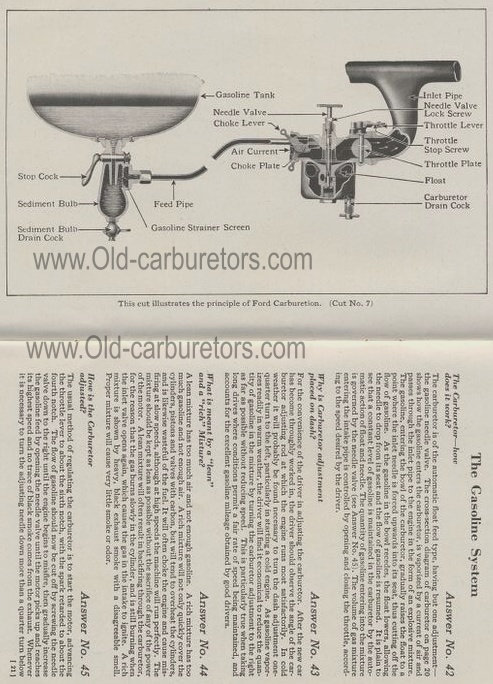First |
Previous Page |
Next Page |
Last | Model T Home
The Carburetor—how
does it work? Answer No. 42
The carburetor is of the automatic float feed type, having but one adjustment
—the gasoline needle valve. The cross-section diagram of carburetor on page
20 shows how the gasoline enters the carburetor, is vaporized by a current
of air and passes through the inlet pipe to the engine in the form of an
explosive mixture. The gasoline, entering the bowl of the carburetor, gradually
raises the float to a point where the inlet needle is forced upwards into
its seat, thus cutting off the flow of gasoline. As the gasoline in the bowl
recedes, the float lowers, allowing the needle to drop from its seat and
the flow of gasoline is resumed. It is plain to see that a constant level
of gasoline is maintained in the carburetor by the automatic action of float
and needle. The quantity of gasoline entering into the mixture is governed
by the needle valve (see Answer No. 45). The volume of gas mixture entering
the intake pipe is controlled by opening and closing the throttle, according
to the speed desired by the driver.
Why is Carburetor adjustment placed on dash? Answer No. 43
For the convenience of the driver in adjusting the carburetor. After the new
car has become throughly worked in, the driver should observe the angle of
the carburetor adjusting rod at which the engine runs most satisfactorily.
In cold weather it will probably be found necessary to turn the dash adjustment
one-quarter turn to the left, particularly in starting a cold engine. As
gasoline vaporizes readily in warm weather, the driver will find it economical
to reduce the quantity of gasoline in the mixture by turning the carburetor
adjustment to the right as far as possible without reducing speed. This is
particularly true when taking long drives where conditions permit a fair
rate of speed being maintained, and accounts for the excellent gasoline mileage
obtained by good drivers.
What is meant by a "lean" Answer No. 44 and a "rich" Mixture?
A lean mixture has too much air and not enough gasoline. A rich mixture has
too much gasoline and not enough air. A rich mixture will not only quickly
cover the cylinders, pistons and valves with carbon, but will tend to overheat
the cylinders, and is likewise wasteful of the fuel. It will often choke
the engine and cause misfiring at slow speeds, although at high speeds the
machine will run perfectly. The mixture should be kept as lean as possible
without the sacrifice of any of the power of the motor. A lean mixture will
often result in backfiring through the carburetor, for the reason that the
gas burns slowly in the cylinder, and is still burning when the inlet valve
opens again, which causes the gas in the intake to ignite. A rich mixture
is shown by heavy, black exhaust smoke with a disagreeable smell. Proper
mixture will cause very little smoke or odor.
how is the Carburetor adjusted?
The usual method of regulating the carburetor is to start the motor, advancing
the throttle lever to about the sixth notch, with the spark retarded to about
the fourth notch. The flow of gasoline should now be cut off by screwing
the needle valve down to the right until the engine begins to misfire, then
gradually increase the gasoline feed by opening the needle valve until the
motor picks up and reaches its highest speed and no trace of black smoke
comes from the exhaust. Whenever it is necessary to turn the adjusting needle
down more than a quarter turn below
[ 21 ]
Answer No. 45
